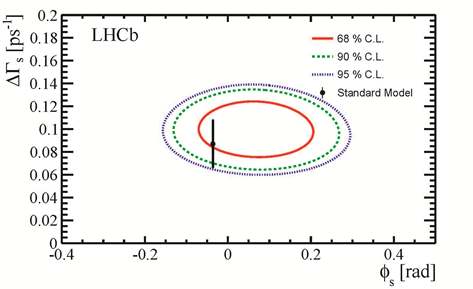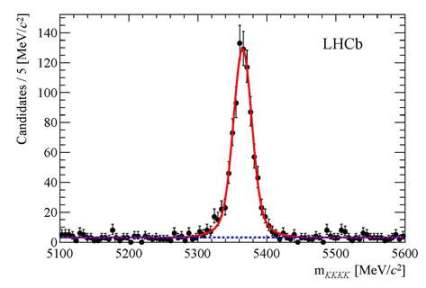[ Δms = 17.768 ± 0.023 ± 0.006 ps-1 ]
[ φs = 0.01 ± 0.07 ± 0.01 rad ]
ΔΓs = 0.106 ± 0.011 ± 0.007 ps-1 ]
The LHCb Collaboration presented today at the Rencontres de Moriond EW, La Thuile, Italy, three important results of their more and more precise search for new physics. The 1 fb-1 data sample collected in 2011 was used to obtain these results.
(1) A fascinating feature of quantum mechanics, in which the B0s, B0 and D0 particles turn into their antimatter partners, has been discussed already at this page, see 15 March 2011 and 7 November 2012 news. This feature is called oscillations (mixing). The B0s mesons oscillate with by far the highest frequency of about 3 million million times per second (3*1012), on average about 9 times during their lifetime.
The B0s meson decays into D–sπ+ were used in this analysis with D–s decays into five different channels. The image at the left hand side illustrates the B0s-B0s oscillations in a spectacular way, showing how the matter turns into antimatter and back over many oscillation periods. The frequency of oscillation is defined by the Δms parameter. The value of this parameter as measured by the LHCb collaboration is shown above.
.
click the image for higher resolution
(2 – presented also at the Rencontres de Physique de la Vallée d’Aoste) Knowledge of the value of the parameter φs is very important for physicists, since it set the scale of the difference between properties of matter and antimatter, called CP violation by experts, in the B0s sector. The B0s decays into a J/ψφ and a J/ψππ were already studied, see 5 March 2012 and 27 August 2011 news for introduction. LHCb physicists have improved and finalized these measurements. One important improvement is in “flavour tagging”, which determines whether the initial state was produced as a B0s or B0s meson. Better tagging gives better sensitivity in the final result. The values of the φs parameter together with the difference between the width of a heavy and light mass B meson system (see 5 March 2012 news) are shown above. The left image below shows the small allowed region for these two parameters.
click the images for higher resolution
(3) Finally, LHCb physicists have opened a door for important future measurements by presenting the results of a first study of the time-dependent CP-violating asymmetry in hadronic B0s meson decays into an φφ pair. Both φ mesons decayed in turn into a K+K– pair. The invariant mass spectrum for the four kaons is presented in the right image above showing a clear accumulation of B0s → φφ decays at the B0s mass. Using about 880 events the CP-violating phase φs was measured to be in the interval of [-2.46,-0.76] rad at 68% confidence level.
The results presented in this news represent the most precise measurements to date. They are in agreement with the Standard Model prediction. The parameter region in which the signs of new physics can still hide is significantly reduced. More details can be found in the LHCb presentations in La Thuile and in the LHCb papers here. Read also the CERN Courier article.



